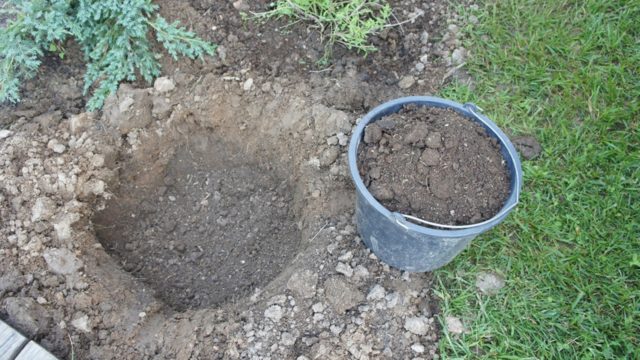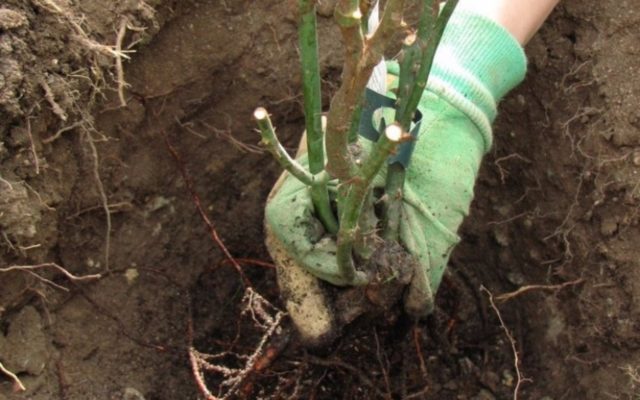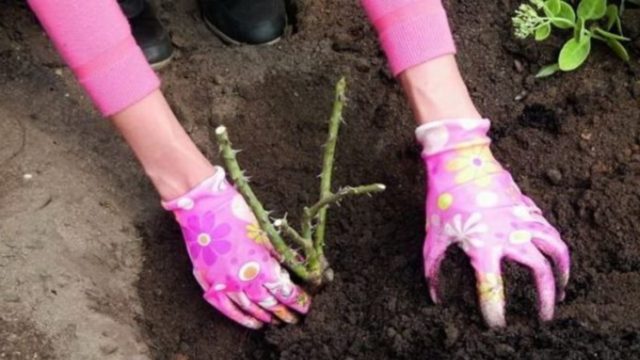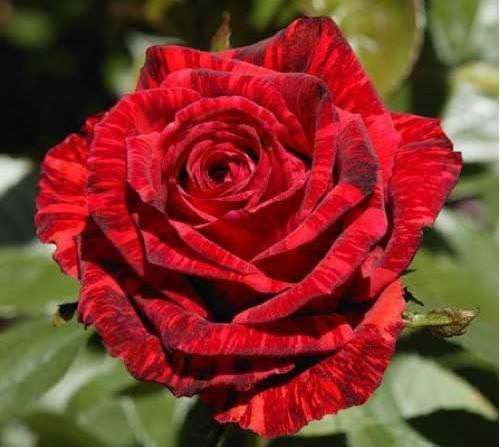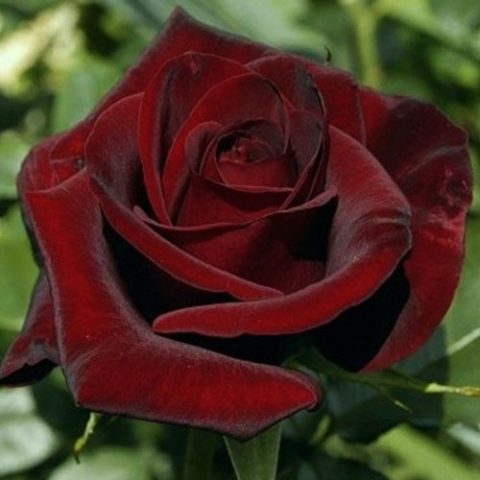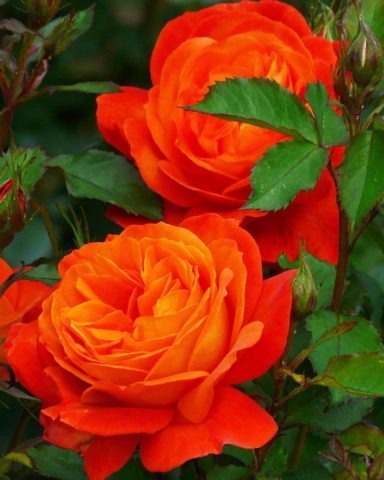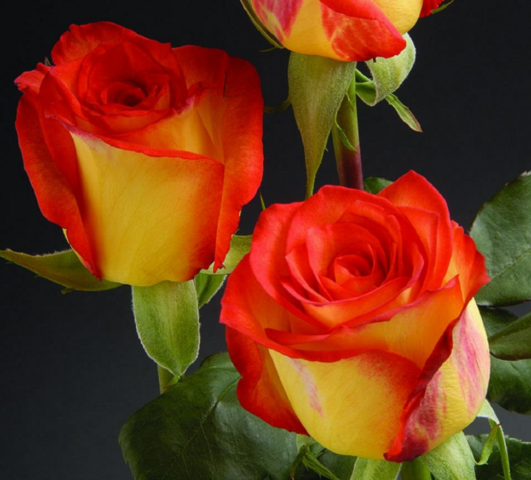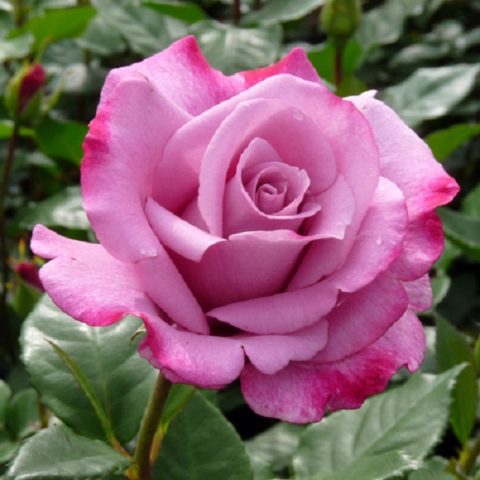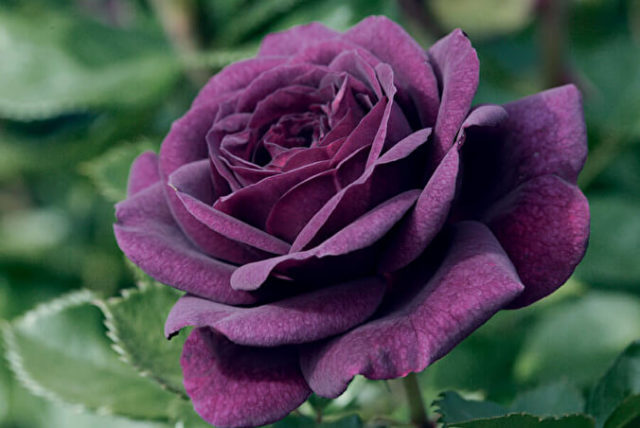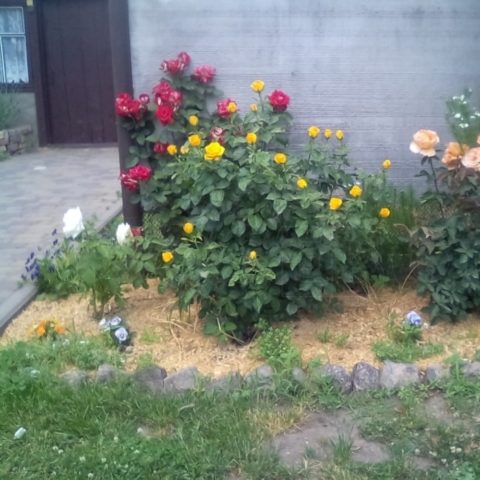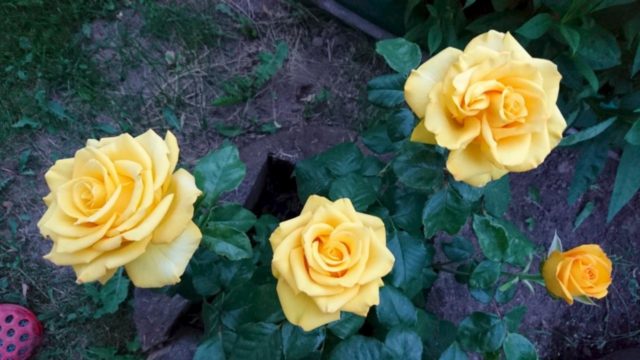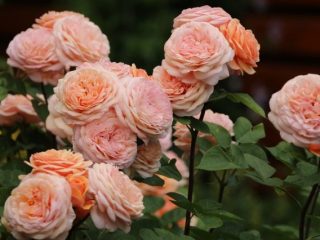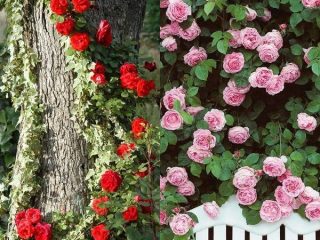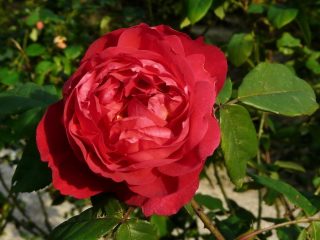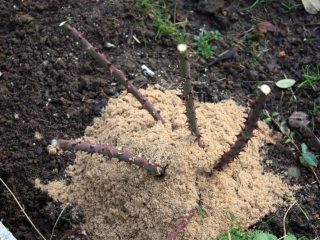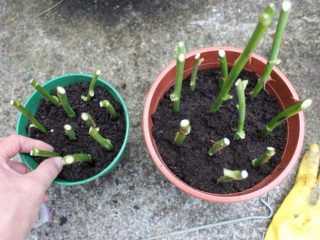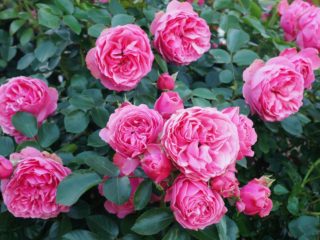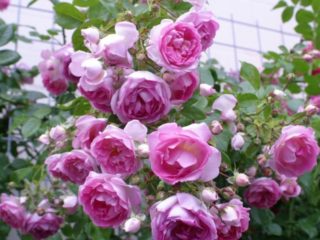Content
- 1 History of selection
- 2 Description of the hybrid tea yellow rose variety Kerio and characteristics
- 3 Advantages and disadvantages
- 4 Reproduction methods
- 5 Planting and caring for rose Kerio
- 6 Pests and diseases
- 7 Application in landscape design
- 8 Conclusion
- 9 Reviews with photos about the yellow rose Kerio
Among the variety of hybrid tea varieties of roses, there are classic types that remain relevant constantly. They are distinguished by the shape of the flower, the uniform color of the petals, the compactness of the bushes, high decorative qualities, and ease of care. These include the Kerio rose of a bright yellow rich hue. It can be found in the garden of almost every gardener, as this variety captivates the eye and cannot get lost even in a large collection.
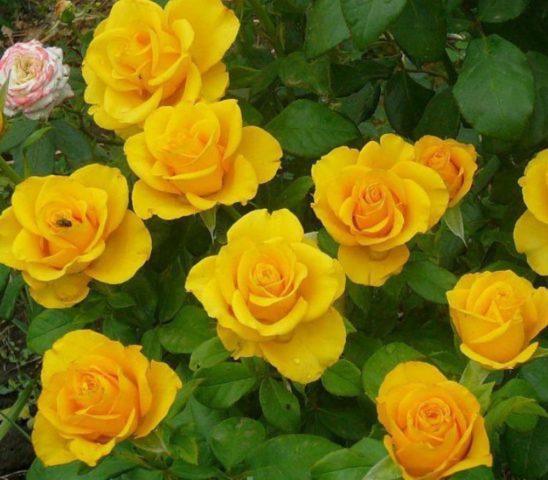
Kerio is one of the brightest yellow varieties
History of selection
This rose was obtained thanks to the employees of the Dutch company Lex+, which specializes in breeding unique varieties. The selection result exceeded all expectations. And in 2002, the Kerio rose was officially registered as a variety called Luxuries. It is ideal for cutting, as it is distinguished by long shoots, goblet-shaped dense flowers and the ability to remain decorative for up to 10 days in a vase. Therefore, this rose variety is widely grown on an industrial scale.
But gardeners did not ignore it either. Kerio has established itself as a highly decorative species, with good frost resistance, and does not require special care. Therefore, it still occupies a leading position in the popularity rating among flower growers, and easily competes with more modern varieties.
Description of the hybrid tea yellow rose variety Kerio and characteristics
Rose Kerio belongs to the category of hybrid tea roses. Its bushes are of medium size, 60-70 cm high, and the growth diameter is about 60 cm. The shoots are erect, densely leafy, with a moderate number of thorns. They can easily withstand the load during the flowering period, so they do not need support.
The leaves of the Kerio rose consist of 5-7 separate segments, which are attached to one common petiole. Their length is 10-12 cm. The plates have a dark green color with a shiny surface, and they have slight serration along the edge.
The root system of the Kerio rose consists of a skeletal tap root, which becomes lignified as it grows. It deepens up to 50 cm. In addition, many lateral processes extend from it. They perform an absorbent function and provide the above-ground part with moisture and nutrients.
This variety of rose is characterized by goblet-shaped flowers with a high center. Their diameter reaches 12-15 cm. Kerio’s petals are dense, which adds volume. When the buds are fully opened, the middle remains closed. The aroma of the flowers is light, combining notes of honey with lemon balm. The hallmark of the variety is the unique bright yellow shade of the petals, which, in combination with dark green foliage, creates a contrast.The bright tone persists for a long time and only under the influence of direct sunlight at the end of flowering can it become paler.
The buds of the variety are apical; they usually grow one on each shoot, but sometimes there can be 3-4 pieces.
Kerio is a re-blooming variety. The bush blooms for the first time in late May early June. This period lasts 3 weeks due to the fact that the buds of this rose open slowly. The second wave of budding occurs in late July early August, depending on the growing region. In terms of the abundance of flowering, it is in no way inferior to the first and can continue until frost.
This variety has good frost resistance. The shrub easily tolerates temperatures down to -23.3 degrees. At the same time, the rose is little susceptible to adverse weather factors.
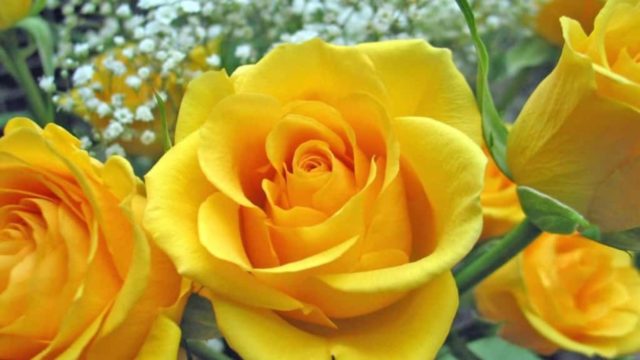
Kerio's flowers are double, each of them consists of 45 or more petals
Advantages and disadvantages
This rose has a large number of advantages, which allows it to remain relevant to this day. But the variety also has its drawbacks that are worth paying attention to. Only by comparing them with other species can one determine how critical they are.
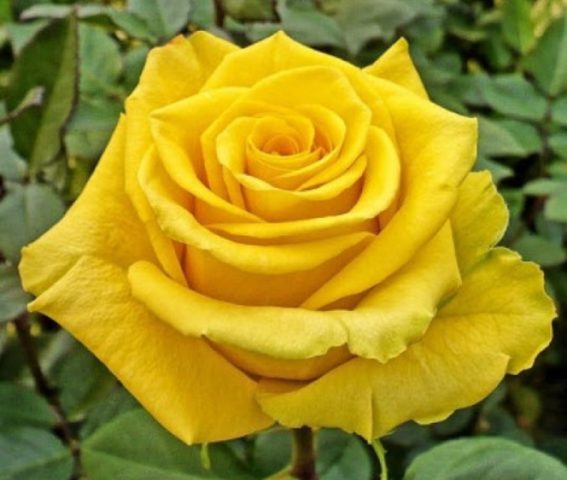
Kerio flowers remain decorative in the rain and gusts of wind
Main advantages:
- bright shade of petals;
- dense, large bud;
- long-term preservation of flower freshness;
- strong, stable shoots;
- long, abundant flowering;
- high commercial qualities;
- low susceptibility to weather factors;
- good winter hardiness;
- resistance to common crop diseases.
Flaws:
- the variety is not capable of self-cleaning, so faded buds need to be cut off;
- high cost of seedlings against the backdrop of increased demand;
- sensitivity to excess organic matter in the soil.
Reproduction methods
To obtain new seedlings of this variety, it is recommended to use the cutting method throughout the entire warm period. To do this, you should cut off the ripe shoots of the current year and divide them into parts 10-15 cm long. Each of them should have 2-3 pairs of leaves. Kerio rose cuttings should be planted in open ground. To do this, you need to remove the lower leaves and reduce the upper ones by half, which will allow you to maintain sap flow.
Planting should be done in a moist substrate, deepening down to the first pair of leaves. In this case, the lower cut of the cutting must be powdered with any root former. At the end of the procedure, a mini-greenhouse should be made on top, which will create favorable conditions. Rooting of Kerio rose cuttings occurs after 2 months. During this period, it is necessary to keep the substrate slightly moist.
Planting and caring for rose Kerio
This variety can be planted in the southern regions in the fall, and in the central and northern regions in the spring. In the first case, the optimal period is considered to be the last ten days of April, and in the second, the end of September. For the Kerio rose, you should choose illuminated areas with light shading during the midday hours and protected from drafts.
The soil should have good moisture and air permeability, and the acidity level should be within the range of 5.6-7.3 pH. It is important that the groundwater level in the area is at least 1 m.
For planting, you need to prepare a hole measuring 50 by 50 cm. Place a layer of broken brick 7 cm thick at the bottom.And fill the remaining volume by 2/3 with a nutrient mixture of humus, turf, peat and sand in a ratio of 1:2:1:1.
Two-year-old Kerio rose seedlings with a well-developed root system and 2-3 mature shoots take root most quickly in a new location.
Algorithm of actions:
- Make a slight elevation in the center of the hole.
- Place a seedling on it, straighten the roots.
- Sprinkle them with earth, fill all the voids.
- Compact the surface at the base and water generously.
Roses should be planted in a row at a distance of 40 cm from each other.
When growing this variety, you should adhere to standard rules of agricultural technology. Watering is carried out 1-2 times a week, soaking the soil under the bush up to 20 cm. It is also important to periodically weed the root circle and loosen the soil. For full flowering, you need to feed the bushes three times a season. The first time in the spring during the active growing season. At this time, you can use organic matter or nitroammophoska. Subsequently, during the formation of buds in the first and second waves of flowering. During this period, superphosphate and potassium sulfate should be used.
For the winter, the Kerio rose needs to be covered. In the southern regions, it is enough to sprinkle the base of the bush with earth and lightly compact it. And the central and northern ones should be additionally covered with spruce branches or agrofibre on top, while shortening the shoots to a height of 20-25 cm.
Pests and diseases
Rose Kerio has increased resistance to powdery mildew and black spot.But if the growing conditions are not met, the bush’s immunity decreases. Therefore, it is recommended to spray the rose 2-3 times per season with copper-containing preparations as a preventative measure.
Among the pests, aphids can cause damage to shrubs. This small insect feeds on the juice of young leaves and shoots of the Kerio rose. With mass distribution, the development of the shrub slows down and the buds become deformed. To combat the pest, it is recommended to use the drug "Actellik".
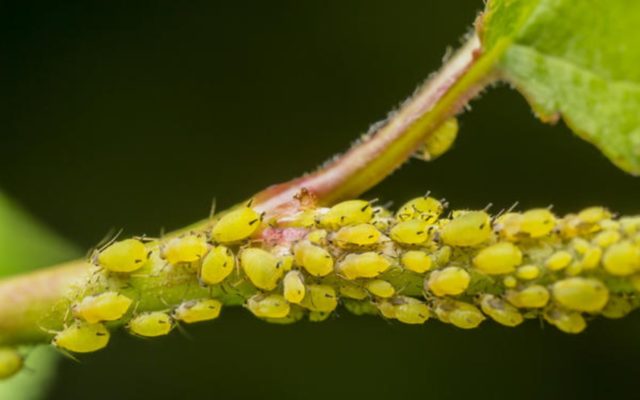
Aphids do not allow the bush to fully develop
Application in landscape design
Rose Kerio looks good both in single and group plantings. As a tapeworm, it is recommended to plant it against a green lawn. The beauty of flowers can also be successfully emphasized by conifers as a background.
When planting in groups, it is recommended to combine the Kerio rose with clematis, delphinium, Carpathian bellflower, thyme, and geranium.
Joint planting of Kerio roses with other roses
When planting Kerio with other roses, yellow shades should be avoided, as against the background of this variety they will all seem too pale.
The following species can become the best neighbors:
- Red Intuition;
- Black Magic;
- Super Trouper;
- Hitch Magic (High Magic);
- Moody Blue;
- Ebb Tide.
Conclusion
Rose Kerio is a unique variety with a bright shade of petals that cannot leave any gardener indifferent. And the shrub’s unpretentiousness to care only contributes to the growth of its popularity. However, when choosing this species, it is necessary to carefully select partners for it, since it can outshine any other variety.
